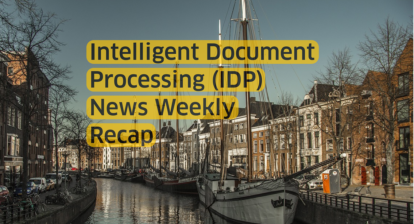Curious about what keeps experts, CEOs and other decision-makers in the Intelligent Document Processing (IDP) space on their toes? Get food for thought on IDP-related topics from the industry’s leading minds.
In this opinion piece, Avi Rafalson, Co-Founder and CEO of IDP vendor DOConvert, explains how Intelligent Document Processing is transforming businesses.
Managing business documents by hand before the digital era was like navigating a dark maze with a penlight.
Mountains of paperwork, stacked on desks.
Endless dull gray filing cabinets lining office walls.
An intricate dance of papers shuffling from department to department by interoffice mail carts.
Finding a needle in the haystack took on new meaning.
Every document was an original, prone to loss or damage.
And when computers finally made their way to everyone’s desk, the paper trail needed to be recorded, by hand, with data entered manually into machines with software that could analyze the data at record speed.
If you wanted to take advantage of vast computing potential in the digital age, you had to endure a “first rite of passage” – the labor-intensive and error-prone processes of manual data entry.
With the emergence of intelligent document processing (IDP), gone are the days of manual document handling or data entry. Instead, organizations are harnessing the power of IDP to streamline operations, unlock valuable insights, and drive unparalleled efficiency.
Why IDP?
As industries continue to navigate the digital revolution, IDP has emerged as a transformative force, reshaping traditional workflows and operational paradigms.
The pace of digital transformation is relentless.
Over the last twenty years, businesses have experienced a monumental leap in efficiency thanks to the widespread adoption and integration of powerful software, sophisticated hardware, and seamless connectivity. Vast amounts of data are accessed and analyzed instantaneously and it has enabled businesses to make informed decisions faster than ever before.
Efficiency gains achieved through the integration of computers into business operations over the last two decades have been transformative, paving the way for increased productivity, innovation, and competitiveness. Intelligent document processing developed with the market’s evolving needs, answering the growing demand for efficiency and automation in document processing.
IDP technology automates and streamlines tasks but it’s not just a tool for enhancing efficiency. It’s a catalyst for a new era of work.
The paper trail had no choice but to evolve into a smarter document processing system. The supply chain industry, in particular, felt the weight of this burden, with the complexity of managing invoices, purchase orders, and shipping documents slowing down operations and affecting efficiency.
IDP’s Tech Capacity
IDP’s advanced technologies like Optical Character Recognition (OCR), Natural Language Processing (NLP), Machine Learning (ML), and Artificial Intelligence (AI) began to transform the landscape.
New programs and algorithms could automatically extract, process, interpret, and re-enter data from various document formats, liberating workflows from manual data entry.
The impact of IDP was immediate and profound.
In the supply chain industry alone, IDP streamlined processes, leading to improved efficiency and better decision-making.
The legal industry witnessed a revolution in document review and research, with professionals now able to focus on more complex legal matters.
Humanity Unplugged
Will IDP technology replace the “human touch”? Or to put it more bluntly, should we be afraid that technology will take our jobs?
The answer is nuanced.
Technology will not completely replace humans. Instead, humans will be replaced by other humans who know how to use technology to their advantage, creating efficient, accurate, and agile workforces.
Adopting IDP technologies isn’t only about controlling a large volume of documents. It’s about processing them efficiently and accurately, reshaping industries, and redefining the very nature of work.
What Can IDP Do For You?
As the paper trail winds its way toward a more digitalized and automated future, IDP is not just reshaping industries; it’s rewriting the rules of the game.
How can IDP change your business?
- Uninterrupted service: With IDP, processes are automatic which ensures uninterrupted operations, giving you a competitive advantage and allowing you to continue to service your customers as you grow your business.
- Data-driven planning and supply chain optimization: With IDP, document reception is immediate, allowing for real-time analysis and more accurate planning. This data-driven approach not only enhances supply chain efficiency but also provides valuable insights for strategic decision-making and forecasting.
- Increased efficiency: With IDP, your organization can increase your profit margin by reducing the time it takes to complete mission-critical tasks. What used to take several minutes can now be done in less than 30 seconds, resulting in cost savings and increased efficiency.
It is an exciting time for businesses to embrace IDP and unlock new levels of efficiency and innovation, heralding a new chapter in the future of work.

About the Author
Avi Rafalson is the CEO of DOConvert, a company at the forefront of Intelligent Document Processing solutions. With a passion for driving digital transformation, Avi is dedicated to helping businesses streamline their document processing workflows and enhance operational efficiency.
📨Get IDP industry news, distilled into 5 minutes or less, once a week. Delivered straight to your inbox:







